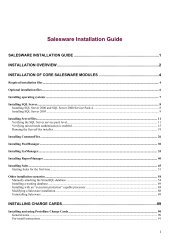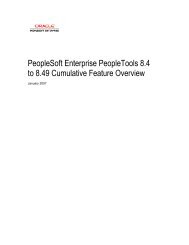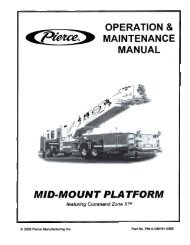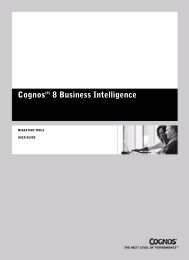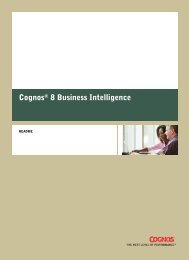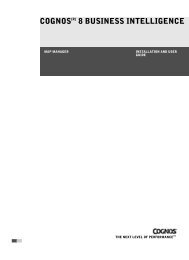COGNOS Business Intelligence Series 7
pes.pdf
pes.pdf
You also want an ePaper? Increase the reach of your titles
YUMPU automatically turns print PDFs into web optimized ePapers that Google loves.
Chapter 5: Provide Drill-through Access<br />
Notes<br />
• You can only drill through from a local source to another local source or from a remote<br />
source (registered on PowerPlay Enterprise Server) to another remote source. For example,<br />
you cannot drill through to a PowerPlay Report (.ppr) from a server-only application such as<br />
PowerPlay Web. Instead, you should drill through to a PowerPlay Portable Report (.ppx) or a<br />
cube (.mdc).<br />
• If users attempt to drill through to a target that is located on a different computer, they may<br />
receive a Cognos Application Firewall rejection message. This is because Cognos Application<br />
Firewall validates URL parameters based on entries in the cern.csx file and the Valid Domain<br />
List in Configuration Manager.<br />
To avoid this situation, add the fully-qualified domain names for the drill-through targets to<br />
the Valid Domain List in Configuration Manager. For more information, see the<br />
Configuration Manager User Guide.<br />
For information about Cognos Application Firewall error messages, see the Cognos<br />
Application Firewall Secure Deployment Guide.<br />
Set Up Drill-through Targets in Transformer<br />
Before users can drill through to other sources of information, the cube that you want to drill<br />
from must contain an embedded list of drill-through targets. This is done in Transformer for<br />
PowerCubes.<br />
Note: To add definitions of drill-through targets to a third party OLAP source, you can use<br />
PowerPlay Connect. For more information, see the PowerPlay Connect Help.<br />
PowerPlay drill-through targets are<br />
• .mdc files (other cubes)<br />
• .ppx files (PowerPlay Portable Reports)<br />
• .ppr files (PowerPlay Reports)<br />
• .iqd files (for Cognos Query)<br />
• .imr files (Impromptu or Impromptu Web Reports)<br />
• .crr files (for Cognos ReportNet or Cognos 8)<br />
If you want drill-through access to be available for all measures in a cube, you define the<br />
drill-through targets in the PowerCube property sheet. If you want drill-through access to be<br />
available for selected measures, you define the drill-through targets in the Measures property sheet<br />
of the specific measure.<br />
Steps<br />
1. Start Transformer and open the model that defines the PowerCube from which you want to<br />
drill through.<br />
2. Do one of the following:<br />
• Open the Measures property sheet for the measure you want to provide drill-through<br />
access on.<br />
• Open the PowerCube property sheet for the cube you want to drill from.<br />
3. In the Drill Through tab, select the Allow Drill Through for this Measure or the Allow Drill<br />
Through for this PowerCube check box.<br />
4. Click the Add button and locate the target file.<br />
Note: For Cognos Query, the .iqd files are stored in a hierarchical folder structure within the<br />
iqdfiles folder on the computer where the Cognos Query server is installed.<br />
Note: For Cognos ReportNet or Cognos 8, select ReportNet Report (*.crr), and type the<br />
correct name for the report.<br />
Tip: This is the report name in Cognos ReportNet or Cognos 8. There is no file with this<br />
name on your computer.<br />
When you choose a report, it is added to the Custom Reports list.<br />
62 Cognos PowerPlay (R)




